| |
|
You would not
think to look for St Michael unless you knew. These days,
a concrete track runs across a nearby field, and
approaches the church through the woods at the rear. But
even then, the building is hidden from view, and you
might easily miss the turning if it wasn't for a sequence
of hand-lettered signs. Better, perhaps, to reach the
tight little graveyard across the fields - after all,
that's been the way for the last 1000 years or so. There
is no village to speak of, and the parish is a scattering
of hidden lanes without any focus, a patchwork of woods
and farms.
St Michael was an estate church in the grounds of Boulge
Hall. But the Hall was demolished in the 1950s. Much of
the grounds had been turned over to cultivation during
World War II, and only the copse of ancient trees marks
out this space among the fields, and the tower seen from
the Debach road. And yet, St Michael receives many
visitors. The church's fame rests on the memory of one
person - or, more accurately, two. Boulge Hall in the
19th century was home to the Fitzgerald family. Their
name is everywhere in the church, they virtually rebuilt
it. Their huge mausoleum, for many years on the Buildings
at Risk register, has been restored, and broods
magnificently beneath the tower. But it is one of the
Fitzgerald sons not buried in the mausoleum who is the
goal of so many pilgrimages. Edward Fitzgerald was born
at adjacent Bredfield. He moved to Boulge Hall when his
parents bought it, and then spent most of his adult life
living in Woodbridge, where a museum documents his life
in some detail, although generally glossing over certain
aspects of his life. In 1859, he translated the Rubiyat
of Omar Khayyam from the Persian, thus establishing
himself as responsible for one of the most famous, and
enduring, pieces in English literature. He died in 1883,
and was buried here. The church is the goal of Fitzgerald
pilgrimages, but also of those paying homage to Omar
Khayyam.
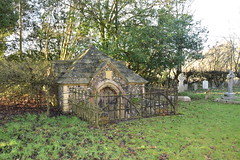 
Fitzgerald is buried
in his own grave, beside his family's mausoleum. The
gravestone is long and sombre, typical of the period. A
rose bush at the head of the grave is supposed to come
from a cutting taken from Omar Khayyam's grave in Iran.
It was planted by the Omar Khayyam society, and one
assumes that cuttings are regularly taken from it in turn
by visitors. Fitzgerald is probably second only to
Benjamin Britten in his fame as a creative artist from
this part of Suffolk. If Britten's homosexuality was
barely acknowledged in his lifetime, you can bet that
Fitzgerald's wasn't at all. But for both of them, their
sexuality seems to have been an important part of their
genius, and in recent years Fitzgerald's friendship with
a Lowestoft fisherman has been movingly documented.
Apart from the tiny 16th century tower, completed on the
eve of the Reformation, the exterior of the church is
thoroughly 19th century, tidy and tight and rather sweet.
It conceals one of the most atmospheric Victorian
restorations in East Anglia, a time capsule of
late-Victorian sentiment. As you approach, the apparent
south door is in fact the vestry door, and you must go
around to the north side, where you can step through a
door in the north wall directly into the tiny nave. On a
sunny day this is a step into almost complete darkness,
as your eyes struggle to adjust. The small windows are
full of thick late 19th and 20th century coloured glass
of the highest quality. Almost all of it is by Clayton
& Bell, including memorial windows to the soldiers of
the Suffolk Regiment killed in 1900 at Colesberg in the
Boer War and to all those killedwhen HMS Duchess sank in
December 1939 after being accidentally rammed by another
British ship. The only other workshop represented here is
that of AJ Dix who was responsible for the 1906 memorial
window in the Fitzgerald aisle. Subjects include the
archangels St Michael and St Gabriel, St Faith and St
Nicholas, Christ flanked by St Edmund and St Felix, the
Annunciation, the Baptism of Our Lord, and, somewhat
strikingly, Queen Victoria.
The overwhelming impression is of a peculiarly East
Anglian early 20th Century Anglo-Catholicism. It is
probably the best single collection of its kind in any
small church in the two counties. The Norman marble font,
primitive and brooding and quite different from its jolly
lion-bedecked cousin at nearby Ipswich St Peter, sits
beneath the tower now, and the tower itself contains one
of the bells rescued from the church of Mickfield when it
was abandoned in the 1970s. Its story is on the adjacent
wall.The restoration is a fairly early one of 1858, by
the Habershons. The church as you see it today is pretty
much as Fitzgerald would have known it.
Ahead of you as you enter, the south aisle is something
quite extraordinary, virtually a family shrine to the
Fitzgerald family. The family pew is surrounded by
memorials to family members, children, cousins,
grandchildren remembered in pious stone and glass. It is
a remarkable achievement for what was not a great landed
family. And what makes it all the more extraordinary is
that, within a few years of its completion, the
Fitzgeralds of Boulge had completely died out.To stand
here now is to be surrounded by the influence of a landed
family at a moment in history when, in an act of extreme
piety, they could ensure their place in posterity. Anyone
who loathes late-Victorian sentiment will not feel easy
here. But for the rest of us this is a marvellous place
that will remain long in the memory.
Simon
Knott, February 2020
Follow these journeys as they happen at Last Of England
Twitter.
 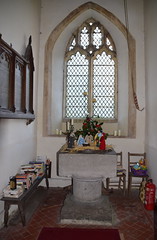 
 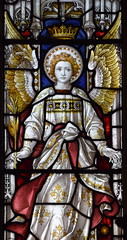  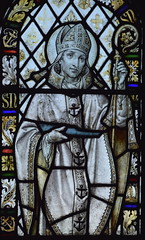 
   
   
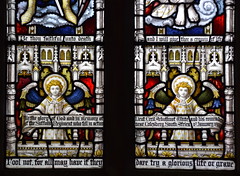  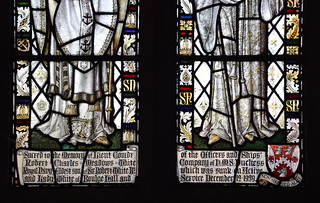
 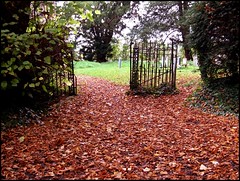
Amazon commission helps cover the running
costs of this site
|
|
|

